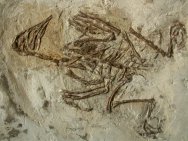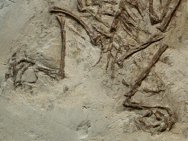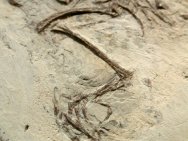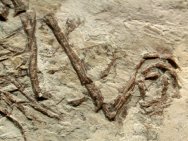 Early
Cretaceous birds from the lacustrine deposits of Western Liaoning
Province are well known for their exceptional diversity, abundance,
and degree of preservation. This one is the Enanthiorinine Cathayornis
yandica. The Enantiornithine birds at one time were the dominant
group of birds during the Cretaceous, only to go the way of the
dinosaurs by the end of the period. Their name is derived in the
meaning “opposite birds” due to a reverse articular
arrangement between the scapula and the coracoid from the typical
birds of today. The fusion of the foot bones is also opposite from
modern birds. Cathayornis derives its genus name from the word Cathay,
an ancient term for China. Paul Sereno, et. al. have synonymized
this one with Sinornis, but not all researchers agree. Cathayornis
(or Sinornis) is one of the few early Cretaceous birds known from
over a dozen nearly complete examples. This one is quite well preserved,
with an intact skull. While they are known to be toothed, the teeth
are not readily apparent here. The wing claws are visible, particularly
in the left wing. Early
Cretaceous birds from the lacustrine deposits of Western Liaoning
Province are well known for their exceptional diversity, abundance,
and degree of preservation. This one is the Enanthiorinine Cathayornis
yandica. The Enantiornithine birds at one time were the dominant
group of birds during the Cretaceous, only to go the way of the
dinosaurs by the end of the period. Their name is derived in the
meaning “opposite birds” due to a reverse articular
arrangement between the scapula and the coracoid from the typical
birds of today. The fusion of the foot bones is also opposite from
modern birds. Cathayornis derives its genus name from the word Cathay,
an ancient term for China. Paul Sereno, et. al. have synonymized
this one with Sinornis, but not all researchers agree. Cathayornis
(or Sinornis) is one of the few early Cretaceous birds known from
over a dozen nearly complete examples. This one is quite well preserved,
with an intact skull. While they are known to be toothed, the teeth
are not readily apparent here. The wing claws are visible, particularly
in the left wing.
Walker,
C. A. (1981): New subclass of birds from the Cretaceous of South
America. Nature 292 |


